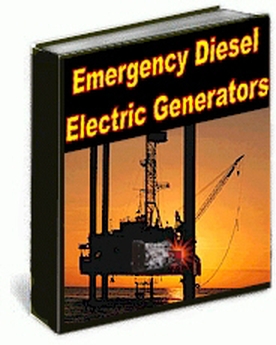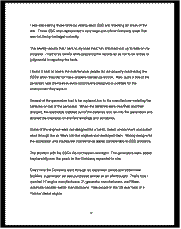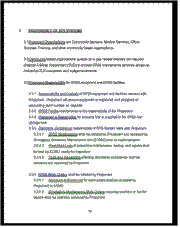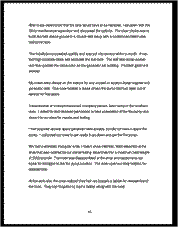Diesel Standby Electric Generator Maintenance PDF
A diesel emergency generator needs a proven maintenance plan.
By Larry Bush

| Diesel Electric Generator Maintenance PDF |
| ESBN: B10-851A-1b33-77B4 |
Description: Research, set up, and operate a new diesel generator maintenance plan. The author tells an interesting story. He set up a diesel generator maintenance team for one of the world's largest oil companies. The case studies backing this plan are from giant corporations. They use automatic transfer switches for multiple diesel standby generators. Even so, smaller companies with one standby generator should use this plan.
A few high-profile diesel generator failures during outages led to a decision by upper management. This resulted in the author's research, detailed in a 96-page PDF. The procedures detail the author's steps in creating the story. They also include examples of how maintenance solved specific field problems.
Learn from Larry Bush. He leads his team to buy, set up, and maintain an Emergency Standby Generator (ESG) for an oil company. It's international. Many of the book's generator maintenance tips also apply to portable generators. |
An email with the download link will sent immediately after purchase. |
| Price: US$19.99 |
Diesel Electric Generator Maintenance PDF Contents:
Chapter 1
SETUP AND IMPLEMENTATION (3)
Chapter 2
SETUP AND IMPLEMENTATION DETAILED OUTLINE (23)
Chapter 3
MAINTENANCE TEAM OPERATING INSTRUCTIONS (31)
Chapter 4
GENERATOR SET PURCHASING SPECIFICATIONS (40)
Chapter 5
EGMU FIELD PROBLEMS WITH EXAMPLES (65)
Chapter 6
IN SUMMARY (96)
Excerpts From the Diesel Standby Generator Maintenance Chapters:
Diesel electric generator setup and implementation:
This book shows how I researched, set up, and ran a new maintenance team for the diesel standby generators at an international oil company. It includes detailed procedures for my work before the maintenance team's startup. It also has examples of how we handled specific field problems.
The company approved and adopted the team's operating instructions. It also adopted the ESG purchasing and fuel tank standards. Various U.S. entities developed and standardized them using their standards. These include the NFPA, NEC, ANSI, and NEMA. It also used European standards, including those recommended by the manufacturer.
Generator Setup and Maintenance Detailed Outline:
B. Training
1. Prepare job descriptions and requirements for each job in the new team. Use the company forms.
2.Get O&IE to approve the diesel mechanic career path for the new maintenance role.
3. Work with the Training Department and O&IE Department to utilize the existing electrical training curriculum for electricians and diesel mechanics training from a local diesel mechanics training provider...
Note: This product is a PDF whitepaper, not a diesel generator training course.
Generator Operation Instructions for Maintenance:
1. DEFINITIONS
1.1 Emergency Power Supply System (EPSS): It may include conductors, disconnecting means, and all control, supervisory, and support devices. These must connect to the transfer equipment load terminals. The system must operate as a safe and reliable source of electric power.
1.2 Automatic Transfer Switch:A device that switches loads between power sources. It does this automatically.
1.3 Bypass-Isolation Switch: A manually operated device. It is part of an automatic transfer switch. It connects the load conductors to a power source. It then disconnects the automatic transfer switch...
Diesel Generator Set Purchasing Specifications:
This specification contains company requirements for synchronous generators and diesel engines. The added requirements for diesel generator sets are from NFPA 37 and 110. Also, the ISO standards 3046 and 8528 provide definitions.
The specification follows the API standards for rotating equipment. It includes several of their standard paragraphs...
Standby Generator Field Problems with Examples:
While maintaining the company-owned ESGs over a large area, several incidents occurred. I will relate some of them in the hope that the information might be helpful to the reader.
The company's Engineering Building in Dhahran had a computer center. It used a 1460 HP Detroit Diesel generator for emergency power. An emergency battery setup in the building provided bridge-over power for up to ½ hour.
The Engineering Building generator faulted and was removed nine months before we took over. The local Detroit Diesel vendor provided a diesel emergency generator for temporary rental.
Diesel electric generator Summary for Maintenance:
The outline's steps to create the diesel generator maintenance plan could also be used to create a different maintenance team. They include research, planning, and implementation. Substitute your maintenance items for the generator sets; you should be home-free.
I have written another e-book called "Maintenance Policy and Procedures". The oil company used this eBook's procedures to form a diesel emergency generator maintenance team.
A functioning team did not spring from the ground full-blown overnight. The total time from conception to completion was 18 months.
It also covers identifying spare parts needs and issues with consumable spares.
These include:
* air filters
* water filters
* oil filters
* fuel filters
* batteries
* starters
* spark plugs
* hoses
* copper tubing
* oil heaters
and other large or fast-moving items.
Free PDF samples:
Please see the three sample PDFs below. They are excerpts from the Emergency Diesel Electric Generator Maintenance PDF.
Emergency Diesel Electric Generator Definitions:
Here are some terms from the generator team's maintenance instructions section.
Emergency Power Supply System (EPSS)
An Emergency Power Supply System (EPSS) is a complete system. It has an Emergency Power Supply (EPS) and a system of conductors, disconnects, and all control devices. It must connect to the transfer equipment load terminal. The system must operate as a safe and reliable source of electric power.
Automatic Transfer Switch (ATS)
An automatic transfer switch is a self-acting device. It transfers load connections from one power source to another.
Bypass-Isolation Switch
A bypass isolation switch is a manual device. It works with and is part of an automatic transfer switch. It first connects the load conductors to a power source. Then, it disconnects the automatic transfer switch.
Level 1 Class EPSS
Level 1 Class EPSS equipment must perform in the most demanding applications. Failure to do so could cause serious injury or loss of life. All Level 1 equipment is a permanent installation.
Level 2 Class EPSS
Level 2 Class EPSS equipment works in less critical applications. Here, the failure of the EPSS is less critical to human life and safety. The authority having jurisdiction should allow more flexibility than Level 1. All Level 2 equipment is a permanent installation.
Level 3 EPSS
Level 3 EPSS equipment includes optional standby systems. It also includes all equipment and apps not in Levels 1 and 2.
The industry standards referenced in this book are:
- NFPA 20 Standard for the Installation of Centrifugal Fire Pumps
- NFPA 30 Flammable and Combustible Liquids Code
- NFPA 37 Standard for Installing and Using Stationary Combustion Engines and Gas Turbines.
- NFPA 70 National Electrical Code
- NFPA 99 Standard for Healthcare Facilities
- NFPA 101 Life Safety Code
- NFPA 110 Standard for Emergency and Standby Power Systems
EPSS equipment covered in this book is:
- Standby and emergency generator sets.
- Controls for engines and generators.
- Automatic transfer switches and controls.
- Engine starting batteries and battery charger.
- Bypass-isolation switch.
- Diesel engine drives for the fire water pump.
- Diesel engine controller for fire water pump.
- Diesel-engine fuel storage system: storage tank(s), piping, and fuel pump(s).
In conclusion, a robust maintenance plan is essential. It ensures your backup generator's reliability and efficiency for your business. Regular maintenance of backup power generators is vital. It boosts their lifespan and cuts the risk of failures in critical operations. Regular inspections and servicing will keep businesses confident in their backup generators. They will be ready for any service interruptions. Following these maintenance protocols will protect your investment. It will also boost productivity and keep operations running in an unpredictable world.
Disclaimer:
The specifications in Larry's book define mandatory requirements governing the design and selection of stationary or portable generator sets (diesel engine-driven) for utility or standby power generation rated 35 KW (50 HP) or more. The specifications do not apply to marine installations. Installations in hazardous locations will require additional features to be specified in the project specification.
Please Tap Contact BIN95 here to contact us with your questions and comments.



